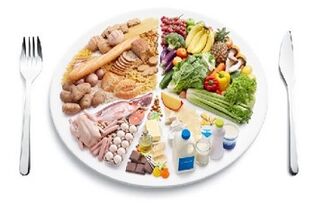
Diet for pancreatitis depends on whether the disease is acute or chronic. Do not forget that inflammation of the pancreas is no small matter, as it plays an important role in digestion, metabolism and assimilation of substances (proteins, carbohydrates and fats). Therefore, once a diagnosis is made, it is necessary to make significant changes in your diet. Otherwise, even the latest generation of drugs will be helpless.
Acute (reactive) pancreatitis
As the name implies, illness occurs suddenly (usually immediately after eating an irritating food). Symptoms: burning pain in the abdomen, fever, nausea, vomiting. Risk factors: lack of protein in food, overeating, alcohol abuse, smoking, fatty, spicy, fried, food too cold or too hot, sweet soda water. Sometimes the disease is the result of gallstone disease and chronic cholecystitis.
Diet for acute (reactive) pancreatitis in adults and children aims to ensure maximum rest of the pancreas for a long time, while at the same time reducing pancreatic and gastric secretions. And here is the sequence of actions the patient should take:
- The first 2-4 days after swelling.It is recommended not to eat at all, but only use medicinal mineral water in small sips and in small amounts.
- Starting from day 5.Gradually and very carefully we developed a diet menu for pancreatitis. For this, it is recommended to adhere to the 5P treatment schedule.
- For 6-7 days.We include in the diet jelly, slimy soup, kefir, liquid porridge (except millet), steamed chicken, beef and fish pieces, mashed potatoes and other vegetables in the form of boiled and stewed, weak tea, roasted apples ormashed, rosehip broth.
Diet menu features and examples
No matter where the patient is sent for the treatment of pancreatitis - to the sanatorium or home, he must adhere to diet number 5, which is based on the following principles:
- Daily vegetable protein rate - 30 g, animal protein - 50 g, vegetable fat - 15 g, animal fat - 45 g and carbohydrates - 200 g. Total calorie intake for pancreatitis should not exceed 2500-2700 kcal per day. The amount of liquid you drink is 1. 5 liters, salt is 10 g.
- For the first two weeks we cooked without salt.
- We eat at least 5-6 times a day in small portions to eliminate the risk of overeating.
- The temperature of cooked food must be between 45 to 60 degrees.
- The consistency of the dish is liquid, semi-liquid, i. e. only purified food.
Diet for acute pancreatitis shows complete exclusion from the menu for long-term (almost a year) smoked meats, fried foods, marinated and pickled, sour cream, lard, canned food, muffins and fresh bread, cream, alcohol. Adhering to all the above recommendations can prevent the development of the disease in chronic form! The example menu for today might look something like this:
- Breakfast:omelet, purified herculean porridge over water, weak tea.
- Second breakfast:cheese with milk.
- Lunch:buckwheat soup, stewed stew, apple jelly.
- Dinner:pieces of steamed fish, carrot puree, rosehip broth.
- For the night:kefir.
Chronic pancreatitis
This disease has another very unattractive name - prediabetes. Indeed, if you have gone through the acute stage badly (if there is no proper treatment), then the next step is diabetes mellitus. The disease is characterized by two alternating stages - enlargement and remission. Thus, a diet with pancreatitis aims to relieve the inflammatory process and, thus, translate the disease into a remission phase.
So, from now on, your diet will be a lifelong eating system. And there is nothing you can do about it. As before, you can take diet number 5 as the basis, the basic principles that we continue to adhere to. Diet by exacerbating chronic pancreatitis is back to the first three steps (fasting with mineral water and further according to the list above).
Approved Products:
- milk, yogurt, kefir, cottage cheese without sour, light cheese;
- porridge (buckwheat, wheat, rice), pasta;
- vegetables (potatoes, carrots, pumpkin, zucchini, beets, etc. );
- wheat crackers or stale white bread;
- meats (beef, chicken, rabbit, turkey), lean fish;
- baked apples, fruit jelly, berry gravity;
- oat broth, fruit drinks, non-acidic fruit juices, chamomile tea;
- vegetable broth and purified soup, celery juice.
Prohibited Products:
- sour fruit, fresh cabbage, beans;
- spinach, sorrel, radish, radish;
- hot spices and herbs;
- fresh bread, pastries, sweets;
- sausages, smoked meats, canned foods, eggs;
- meat, fish broth, cabbage soup, borsch;
- alcohol, sweet drinks with gas;
- candy, ice cream, sour cream, cream;
- fried food.































